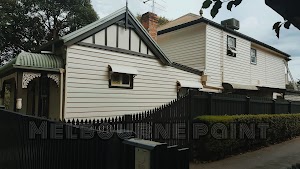Introduction
Painting buildings is the most cost-effective way to renovate the visual appearance of a home. It’s also one of the most common and simplest methods available to breathe new life into structures. Therefore, in this article, we intend to familiarize you with this practical art. So, for consultation and meeting your needs, you can access skilled and expert individuals with just one click at Melbourne Paint.
In this article, you will become familiar with the following topics:
- Tutorial on building painting
- Is painting affected by light?
- Painting different spaces
- Building painting
What is Color?
Color does not exist; rather, it is created in our brains. As you know, we need light, objects, and eyes to see color. In fact, color emerges in the presence of light. When light falls on an object, some rays are reflected by the object and the rest are absorbed. The part that is reflected determines the color.
Understanding Color
Our eyes cannot perceive the light absorbed by an object. For example, an apple absorbs all colors except green. Since green color is reflected and captured by our eyes, we see the apple as green.
Additionally, when all light rays are absorbed, black is formed, and when all light rays are reflected, we see white. It is worth noting that a black object absorbs all colors and is sometimes described as colorless for this reason. Therefore, black objects absorb more heat compared to white objects, as white reflects all colors or wavelengths.
With this understanding of the basics of color, we can better comprehend the following explanations and avoid confusion in describing and interpreting colors.
Description of Color
Describing the relationship between colors and the various qualities that govern them, or even many existing studies on theories, is as complex as the structure of coloration itself. However, generally speaking, color can be associated with three important concepts:
- Psychology
- Symbolism
- Mysticism
Furthermore, colors have taken on different meanings based on artistic, historical, or cultural periods. Even a color may have a specific meaning in different countries based on their culture. But what we are discussing here today is building painting, which, despite various tastes, requires analysis. It’s through this analysis that the best type of paint for a particular space is chosen.
Different Tastes in Building Painting
It’s enlightening to take a look at some of the famous architectural theories.
- Louis Barragán emphasizes the purity of color, portraying space as an emotional stimulant.
- Le Corbusier adheres to the achromaticity of surfaces.
- Zaha Hadid utilizes red in some architectural elements.
- Diego Rivera adopts thick colors inspired by Mexican culture.
Tutorial on Building Painting
In general, if we create an environment with neutral walls, floors, and ceilings, applying specific colors to different surfaces gives us different visual effects. For example, if we paint all the surfaces of a house white and only use different colors on some walls or ceilings, we perceive a different sense of space.
For instance, applying a darker shade to the ceiling creates a sense of confined space. Painting the central wall of a space makes it appear smaller than it is. However, if applied to all walls, it gives us the perception of a larger space than actually exists.
Tip
If only the side walls of a space are painted, the existing space appears narrower. Otherwise, when painting the central wall and ceiling with the same color, the environment appears larger. If you’re looking to lower the perceived height of the space or focus your attention upward (eye level), start painting all surfaces from the mid-point of the walls and also cover the ceiling. Applying darker colors to upper surfaces gives us a desirable effect.
Is Painting Affected by Light?
We’ve touched on this topic before. Colors do not exist without the presence of light, as Israel Pedrosa mentions in his book “Coral Inexistente.”
Color has no material substance; it’s merely a sensation created by certain neural organizations under the influence of light. With closer scrutiny, it indicates the visual organs’ practical action stimulated by light.
Color is closely related to psychological stimuli and can be used in relation to the volume and shape of each project. In such a structure, we can say what psychological effects colors have on us.
Psychology of Colors
Blue: Conveys positivity, confidence, and security. Often used in commercial spaces such as banks, offices, and companies.
Yellow: Portrays optimism, curiosity, cheerfulness, and a bright atmosphere. Frequently used in commercial spaces or restaurants to attract pedestrians’ attention.
Red: Represents energy, excitement, and a high tempo. Therefore, it’s commonly used in commercial spaces, including shops or fast-food centers, as it strongly attracts consumers’ attention and urges specific actions.
Green: Evokes calmness and health. Often used in spaces related to health and well-being, such as hospitals and relaxation centers.
Orange: Resulting from the combination of yellow and red, orange has a noticeable output. It signifies:
- High energy
- Creativity
- Joy
- Enthusiasm This color is often used in creative environments such as offices, studios, and schools. When combined with blue, it conveys stimulation and trust, hence its usage by agencies and banks.
Purple: Conveys well-being, tranquility, and softness.
Building Painting
Color is an integral element in architecture. This aspect is not only significant in terms of aesthetic perception but also in terms of emotional and sensory importance. Therefore, color should be used thoughtfully in projects. This becomes particularly important when delving into the topic of residential painting. Residential painting often encounters variations due to the diverse tastes and preferences of individuals. However, experts generally adhere to a basic pattern of painting in homes.
Painting Different Spaces
Building painting, depending on its usage, has its own specific coordinates to achieve the best outcome in conveying feelings and impact. Below are three cases of spaces where reflection can greatly aid in color selection:
Children’s Room Painting
In painting projects for children, colors are used to stimulate psychological and sensory growth. Among the numerous examples of these colors, the following can be noted:
-
- Orange
- Spring Green
- Yellow
- Blue
- Pink It should be noted that colors aligned with cheerful tones are more beneficial for children.
Hospital Painting
In hospital projects or in the healthcare sector, colors are used as a complementary element for patient rehabilitation. These colors include:
- Green
- Ivory
- Grey
- Blue And more…
Urban Painting
In urban projects, colors are sometimes used to rejuvenate and revitalize deteriorating spaces. Beautifying a city with a wide spectrum of colors can be achieved, focusing on the desires of the target community. If the city is experiencing urban decay, colors that evoke a sense of novelty should be used. If the city has been affected by natural disasters, it is better to use colors that convey a sense of calmness accompanied by regeneration and revitalization.
Melbourne Paint Statement
Sometimes, due to various circumstances or the passage of time, indoor spaces may feel dull or dirty, giving a sense of lifelessness to the environment. In such situations, with a simple measure, we can transform these gloomy spaces, where painting is one of the unique options. It’s no slogan that building painting is one of the impactful elements in improving the quality of living spaces. For this reason, we have addressed this topic scientifically and foundationally in this article so that you can take action with full awareness.
We hope that in this article, we have provided you with useful and actionable information



















